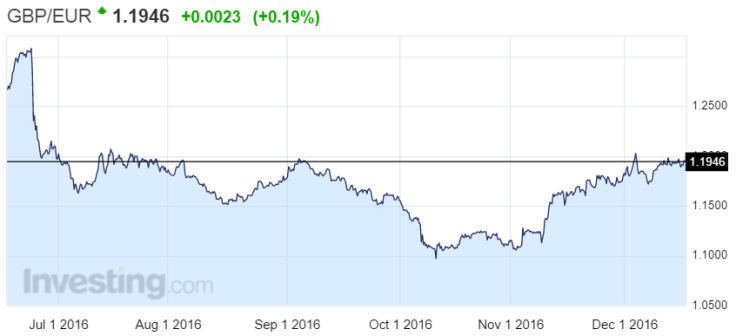Dollar, pound, euro or yen: Which currency should you invest in?
The US dollar could become the strongest major currency in 2017 as interest rates look set to rise.
2016 has been a very eventful year for currencies around the world, thanks to a number of key political events.
Sterling: All about Brexit
Brexit was the first key event that surprised the foreign currency markets back in late June, with sterling the obvious casualty of the Yes vote.
Before the vote, one pound bought nearly $1.50, but now you would be lucky to get $1.25 (see chart 1). Interestingly, the pound did not reach this year's low point until the middle of October.
Will the pound regain strength in 2017?
The British government will trigger Article 50 and begin negotiating with the European Union in 2017. This event will help to determine the direction of the pound against key currencies, most obviously against the euro, next year.
But other factors will also have an important influence on the pound. Sharply rising inflation is forecast for the British economy, which should drive the Bank of England to raise its base interest rate in the next few months.
This, combined with the fact that the pound is currently undervalued on a purchasing power parity basis, suggests that the pound will strengthen against the euro over 2017. Since mid-October, sterling has recaptured some of its post-Brexit vote losses (see chart 2), currently sitting at €1.19.
At BNP Paribas, global head of FX Strategy Steven Saywell is positive on the pound, as he believes that the markets have already priced a worst-case scenario ahead of Brexit negotiations. According to Steven, sterling will rise against the euro to €1.25 per pound by the end of 2017, as some of the pound's undervaluation is corrected as the Bank of England likely raises interest rates.

US Dollar to be a 2017 winner

The surprising US presidential election win by Donald Trump has led to more optimistic forecasts of US economic growth in 2017, as he is slated to cut taxes and invest in infrastructure and defence.
At the same time, the US central bank, The Federal Reserve, is expected to raise interest rates stateside as inflation rises.
The US dollar index (which measures the US dollar against a combination of currencies) has appreciated 10% since the middle of 2016

And I expect that these two factors of higher inflation and higher interest rates together will lead the US dollar to appreciate further next year.
Euro a likely loser next year
The key events likely to shape the direction of the euro in 2017 are the upcoming parliamentary and presidential elections in various member countries of the Eurozone:
- March 15: The Netherlands – Parliamentary elections
- April 23 and May 7, 2017: Rounds 1 and 2 of the French Presidential election
- June 11 and June 18, 2017: Rounds 1 and 2 of the French legislative election
- Autumn (August-October) 2017: German parliamentary elections
These elections will introduce a lot of uncertainty into the Eurozone, which could well weigh on the currency over the next year.
At the same time, the European Central Bank is very unlikely to raise interest rates in 2017 as inflation remains very low, and unemployment uncomfortably high across France, Spain and Italy.
BNP Paribas sees the euro at parity against the US dollar by end-2017, so weaker than it is today.
So of the major currencies, the US dollar looks set for further strength as we go into the new year.
One easy way to get exposure to the US dollar is via an exchange-traded fund holding US dollar assets like shares or bonds.
One exchange-traded fund (ETF) that can be bought like a share and which give the holder exposure to the US dollar is the Pimco short-term high yield corporate bond index ETF (code SSHY in London).
This ETF is priced in pounds and invests in US-based high yield corporate bonds. It will thus benefit from any US dollar strength, and currently has a dividend yield of 5%, attractive to income-seeking investors.
© Copyright IBTimes 2025. All rights reserved.


















